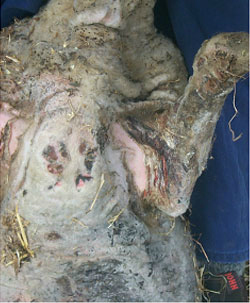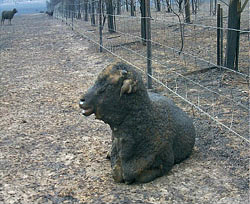Assessing sheep after a bushfire
Download this page: Assessing sheep after a bushfire ![]() [MS Word Document - 956.4 KB]
[MS Word Document - 956.4 KB]
Sheep are common victims of bushfires in Victoria.
Often large numbers are affected when they mob themselves into corners of paddocks against fences, where they are burnt or suffocate. Burns sustained often reflect this behaviour, with animals on the outside burnt around the face or tail. Those in the middle may escape injury completely.
Wool is a good insulator that protects the sheep's body from intense radiant heat. Sheep in full wool are less likely to suffer severe burns than sheep off-shears. The outside of the fleece can be quite charred, yet the underlying skin may be completely unaffected.
Initial assessment
After a fire, teams from Agriculture Victoria are assigned impacted areas to assess damage and animal and human welfare needs. The initial concern will be to destroy livestock that are suffering.
Some sheep will need to be destroyed immediately, because they will be too severely burnt to survive and it would be inhumane to keep them alive.
All other sheep able to walk must be yarded for assessment. The assessment would usually occur on the following day.
Four assessment categories can be used:
- Destroy immediately.
- Send for salvage slaughter.
- Keep and nurse or re-assess.
- Animals without apparent damage.
Category 1 – Destroy immediately
Sheep should be humanely destroyed as soon as possible if they are:
- unconscious or semi-conscious
- those down and unable to walk
- those with extensive burns to bare areas
- those with major swelling of the limbs
- those showing respiratory difficulties from smoke-damaged lungs.






Category 2 – Salvage slaughter (if practical)
Moderately burnt sheep will survive at least the next few days. They may be heavily singed on the wool with only minor burns to non-wool areas. The non-wool areas include the:
- face
- ears
- lips
- forelegs
- teats
- anus
- between the legs.
Salvage slaughter at an abattoir is usually not an option with wool-type sheep when prices are low or when abattoirs are distant. In addition, sheep must be fit enough to be transported. Bare areas with hardened cracking skin usually have subcutaneous oedema and congestion, causing difficulty with skinning and can result in carcass condemnation.

Slaughter at an abattoir is an option for unburnt sheep on farms with no feed left. Unburnt sheep can be held satisfactorily at abattoirs, but the condition of even mildly burnt sheep can deteriorate rapidly. This is an important consideration when large numbers of sheep are affected and abattoirs are over-supplied.
Category 3 – Keep and nurse
Mobile and alert animals with only moderate burns to less than 10 to 15% of their body are generally good candidates for retention, provided that suitable facilities, labour, fresh water and feed are readily available. Treatment and recovery is likely to be long and difficult, with no guarantee of success. Sheep must be inspected daily, and those seen to be deteriorating must be humanely destroyed.
Burnt animals are reluctant to move and usually do not feed for a few days. Their appetite will return after about a week.
They should be given high-protein feeds, such as good lucerne or grass hay, or green summer crops or lucerne, to aid healing. Inspect animals often to ensure they can move to water and drink. Those unable to drink should be destroyed.
Sheep with minor visible cracking around the coronet will be very lame and sore. Where possible place sheep on soft level ground, especially if their feet are burnt.
Transport of these animals over large distances will cause unnecessary pain and suffering. These sheep should be held in a hospital mob for reassessment and destroyed if necessary.
Long-acting antibiotic, especially for more severely burnt animals, will help prevent secondary infection. Consultation with your private vet will be essential.
Check all animals regularly for signs of flystrike, both on burnt areas of the body and on the feet.
If an ongoing commitment to good nursing is unlikely, then affected animals should be humanely destroyed as soon as possible.
Category 4 – Animals without apparent damage
These are sheep that are apparently undamaged or have minor singeing of the wool and facial area but with sound feet. They should survive but must be re-assessed in 5 to 7 days.
Particular attention should be paid to breathing difficulties caused by smoke inhalation, which may take some time to become evident.
Stock must be yarded to ensure adequate inspection.
What do I look for?
Severe burns in sheep are generally confined to the bare areas of skin not protected by fleece wool – the udder, anus, vulva, lips, nose and face, belly, and most importantly the feet and legs.
Severe burns may not be obvious at first, but after 2 to 3 days the skin appears dry, scorched and leathery. There is often swelling and release of fluids or sloughed skin.
Feet and legs
The most important factor for survival is mobility. Often after a bushfire sheep are forced to stand on burnt ground, resulting in hoof injuries in addition to leg burns sustained in the fire. Severely damaged legs will be swollen and the skin leathery with underlying tissue damage.
These animals eventually go down and, unable to rise or walk to water and feed sources, die.
If hooves are lost the animals must be destroyed regardless of other burns.
Walking directly on the pedal bones causes considerable pain. Cracking or exudation of the hooves at the coronet is clear evidence that the hoof will be shed within a few days – these sheep should be destroyed.
The inside of the legs and feet
It is important to tip and examine the underside of affected sheep. The axilla and inguinal areas should be examined for severe burns that cause the skin to split and slough. Burnt skin of sheep does not blister but will harden and crack over the following days, causing the sheep to become immobile and lethargic and preventing feeding.
Even with intensive treatment, it is rarely possible to save sheep with greater than 15 per cent of their body burnt (less if vital areas are burnt).
Face, lips and eyes
Burns to the face generally heal well and are not life threatening. However, swollen burnt lips hinder feeding and affected sheep may lose several kilograms of body weight. If the animal is unable to eat satisfactorily because of damaged lips, it may be necessary to destroy it on humane grounds.
Burns to the eyes or corneas may take several weeks to heal and often result in subsequent scarring causing blindness. Injuries to the eyelids will interfere with the normal blink reflex and the ability to clean the eye and protect it.
Animals with nasal discharge, laboured breathing or abnormal sounds, indicates smoke inhalation and respiratory burns.
Affected sheep can develop lung abscesses and most die within a few days or weeks of being burnt.
Genitalia, anus and udders
Burns to the groin, udder, anus and vulva may take weeks to heal if a large area of skin is affected. Although not life threatening, they eventually heal, provided there is no secondary infection, and flies are kept away.
Burns to the pizzle heal well, provided the swelling and scabs do not block the pizzle opening, preventing urination.
Burns to the scrotum on rams also heal well, but sperm quality and hence fertility may be reduced for several months.
The udders of ewes should be examined. Scar tissue can close the orifice of badly burned teats, but minor scabs will usually shed after a few weeks, leaving teats functional. Severe burns to the anus can cause faecal incontinence if sphincter muscles are damaged.
Other considerations
The decision to destroy affected sheep should be made on animal welfare grounds. Allowing animals to suffer is unacceptable.
Other factors to be taken into consideration when assessing and dealing with burnt sheep are:
- The availability of feed and water – is there enough feed and water left on the property to sustain the remaining sheep or is agistment available?
- Is there adequate labour to provide the necessary care and attention for burnt stock?
- What are the insurance arrangements?
- Are remaining facilities, yards and fencing suitable and available?
- What is the prognosis for future productivity and reproductive performance?
Disposal
Quick, thorough disposal of dead stock is most important as burnt carcasses will decompose rapidly and become a breeding place for flies. Such carcasses are then difficult to handle.
Your local municipality is the agency responsible for burial of dead stock although the process is usually facilitated through Agriculture Victoria Animal Health staff.